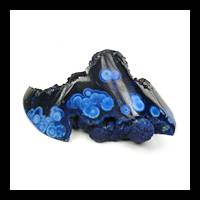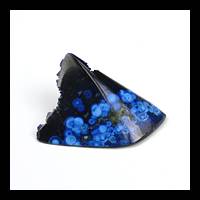Azurite

Arizona, USA
44.07 carats
© Palagems
Azurite is famous for its superb colour and interesting forms. It was formerly used for azure pigment. It can be cut into cabochons, faceted into gems and used for ornamental objects.
Azurite dust is toxic and must not be inhaled when cutting and polishing.
Azurite is also known as chessylite after the type locality at Chessy-les-Mines near Lyon, France.
Azurite Gemstones by Colour
This table shows the variety of hues this gemstone can be found in. Click on a photo for more information.
Azurite Gemstones by Size
This table shows distribution of Azurite gemstone sizes that are listed on this site. This can give a good indication as to the general availability of this gemstone in different sizes.
Contributed photos
Lightest:1.90 cts
Heaviest:44.07 cts
Average:22.64 cts
Total photos:5
Do you have a larger Azurite? Why not upload a photo?
| General Information | ||||||||||||||||||||||
|---|---|---|---|---|---|---|---|---|---|---|---|---|---|---|---|---|---|---|---|---|---|---|
| Other Names/Trade Names: | ||||||||||||||||||||||
| Chemical Formula |
| |||||||||||||||||||||
| Azurite Treatments | ||||||||||||||||||||||
| May be coated with colorless wax - Blue Chart Gem Identification, Herve Nicolas Lazzarelli, 2010, p 3 | ||||||||||||||||||||||
| Physical Properties of Azurite | ||||||||||||||||||||||
| Mohs Hardness | 3.5 to 4, Blue Chart Gem Identification (2010) More from other references | |||||||||||||||||||||
| Specific Gravity | 3.70 to 3.90, Blue Chart Gem Identification (2010) More from other references | |||||||||||||||||||||
| Tenacity | Brittle, Gemstones of the world (2001) | |||||||||||||||||||||
| Cleavage Quality | Indistinct, Gemstones of the world (2001) More from other references | |||||||||||||||||||||
| Fracture | Conchoidal, Gemstones (2009) | |||||||||||||||||||||
| Heat Sensitivity | Sensitive to heat., Gemstones (2009) | |||||||||||||||||||||
| Light Sensitivity | Bright light may reduce its colour., Gemstones (2009) | |||||||||||||||||||||
| Optical Properties of Azurite | ||||||||||||||||||||||
| Refractive Index | 1.720 to 1.850, Blue Chart Gem Identification (2010) BlinkingMore from other references | |||||||||||||||||||||
| Optical Character | Biaxial/+, Blue Chart Gem Identification (2010) More from other references | |||||||||||||||||||||
| Birefringence | 0.108 to 0.110, Blue Chart Gem Identification (2010) DoublingMore from other references | |||||||||||||||||||||
| Pleochroism | Distinct: dark-blue - light blue, Blue Chart Gem Identification (2010) More from other references | |||||||||||||||||||||
| Dispersion | Visible, Gemstones (2009) | |||||||||||||||||||||
| Colour | ||||||||||||||||||||||
| Colour (General) | Dark blue, azure blue, Gemstones of the world (2001) More from other references | |||||||||||||||||||||
| Causes of Colour | Blue, Cu2+ in elongated octahedral coordination, Pragmatic Spectroscopy For Gemologists (2011) | |||||||||||||||||||||
| Transparency | Transparent,Translucent,Opaque, Gemstones of the world (2001) More from other references | |||||||||||||||||||||
| Lustre | Vitreous, Gemstones (2009) | |||||||||||||||||||||
| Fluorescence & other light emissions | ||||||||||||||||||||||
| Fluorescence (General) | None, Gemstones of the world (2001) | |||||||||||||||||||||
| Crystallography of Azurite | ||||||||||||||||||||||
| Crystal System | Monoclinic, Blue Chart Gem Identification (2010) More from other references | |||||||||||||||||||||
| Habit | Crystals of varied habit, often in spherical radiating groups. It is common in botryoidal or stalagmitic groups and massive in veins with malachite., Gems, Sixth Edition (2006) More from other references | |||||||||||||||||||||
| Geological Environment | ||||||||||||||||||||||
| Where found: | Azurite is found in the oxidized zones of copper deposits and is very often intimately associated with malachite to the extent that the name azur-malachite has been used., Gems, Sixth Edition (2006) | |||||||||||||||||||||
| Inclusions in Azurite | ||||||||||||||||||||||
| Common as banded aggregate in wavy pattern: often intergrown with malachite - Blue Chart Gem Identification, Herve Nicolas Lazzarelli, 2010, p 3 | ||||||||||||||||||||||
| Further Information | ||||||||||||||||||||||
| Mineral information: | Azurite information at mindat.org | |||||||||||||||||||||
| Significant Gem Localities | ||||||||||||||||||||||
| ||||||||||||||||||||||



